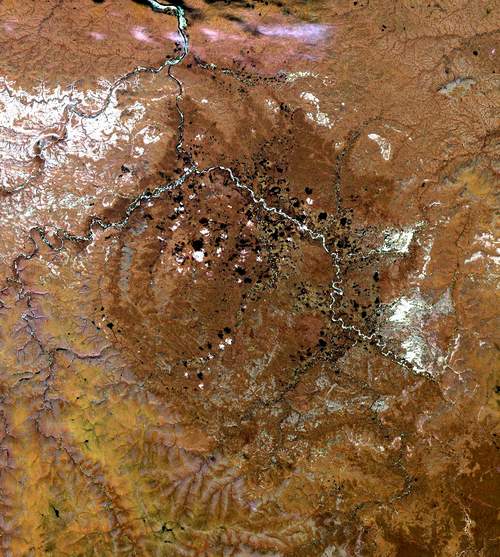Credits: NASA
http://www.theage.com.au/technology/sci ... 2659r.html
Diamonds in Popigai Crater
Diamonds in Popigai Crater
Last edited by Rothkko on Fri Sep 21, 2012 6:56 pm, edited 4 times in total.
Re: Diamonds Beneath the Popigai Crater
Yes, I saw this on the TV news. Apparently the conditions for forming diamonds at the impact site were just right for only a few moments, so there was no time for forming large, clear diamonds. Therefore the diamonds are small and gray. On the other hand they are very numerous, and they can be great for industrial use!
Ann
Ann
Color Commentator
- neufer
- Vacationer at Tralfamadore
- Posts: 18805
- Joined: Mon Jan 21, 2008 1:57 pm
- Location: Alexandria, Virginia
Re: Diamonds Beneath the Popigai Crater
http://en.wikipedia.org/wiki/Popigai_Astroblem wrote: <<The Popigai crater in Siberia, Russia is tied with Manicouagan Crater as the seventh largest verified impact crater on Earth. A large bolide impact created the 100 kilometres diameter crater 35.7 ± 0.2 (2σ) million years ago during the late Eocene (Priabonian stage). The crater is 300 km (1½ hours by helicopter) east from the outpost of Khatanga and 880 km NE of the city of Norilsk. It is designated by UNESCO as a Geopark, a site of special geological heritage.
Popigai is the best example yet of the formation of a crater of this type. Six other craters are larger; some are either buried (Chicxulub), strongly deformed (Sudbury), or deformed and severely eroded (Vredefort). There is a small possibility that Popigai impact crater formed simultaneous with the approximately 35 million year old Chesapeake Bay and Toms Canyon impact craters.
For decades the Popigai crater has fascinated paleontologists and geologists, but the entire area was completely off limits because of the diamonds and the mines constructed by gulag prisoners under Stalin; however, a major investigatory expedition was undertaken in 1997 (IPEX 1997) which greatly advanced understanding of the enigmatic structure. The impactor in this event has been identified as either an 8 km diameter chondrite asteroid, or a 5 km diameter stony asteroid.
The shock pressures from the impact instantaneously transformed graphite in the ground into diamonds within a 13.6 km radius of the impact point. Diamonds are usually 0.5 to 2 mm in diameter; a few exceptional specimens are 10 mm in size. The diamonds not only inherit the tabular shape of the original graphite grains but they additionally preserve the original crystal's delicate striations.
In September 2012, Russia officially stated there are massive diamond reserves under the crater containing "trillions of carats" (hundreds of thousands of tons) and claimed there are enough diamonds in the field to supply global requirements for 3,000 years. This could alter the market for industrial diamonds, presumably by making them more plentiful and lower cost. Many of the diamonds at Popigai contain crystalline lonsdaleite, an allotrope of carbon that has a hexagonal lattice. These stones are 58% harder than ordinary diamonds if pure.The diamonds also "contain unusual abrasive features and large grain size" which could make them extremely useful for industrial and scientific applications. These types of diamonds are known as "impact diamonds" because they are thought to be produced when a meteorite strikes a graphite deposit at high velocity.>>
Art Neuendorffer

